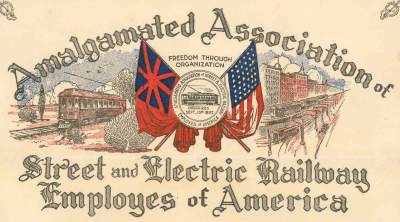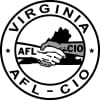
When the Amalgamated Association of Street Railway and Motor Coach Employees of America, Local 1177 was chartered in 1939, it represented bus drivers and diesel mechanics. Our employer was still Virginia Electric and Power Company, who had previously operated electric street cars in Norfolk and Richmond. (Richmond was represented by AASRMCEA Local 1220 later that year.) But during the Second World War, Norfolk returned to electric street cars because all steel and rubber production was diverted to the war. It had been only 13 years since Norfolk switched to buses, and the tracks and power lines were still in good condition. The electric street cars ran until January 10, 1948. After the final street car run from City Hall Avenue to Oceanview Station, Norfolk returned to rubber-wheeled buses exclusively.
Our first fight occurred before the Union was even chartered. In 1937, while the workers were preparing to form a union, the company formed their own internal union and immediately signed a closed shop and checkoff arrangement through the false union. "Closed shop" means the company will hire only union members, and the employees must remain members in order to keep their jobs. The checkoff is a payroll deduction of union dues. Then the company started deducting dues from all employees and fired those who refused to recognize the false union. In the end, the company was found guilty by NLRB of unfair labor practices (coercing and captive-audience meetings) and ordered to repay $90,000 in dues to the employees.
This occurred during a contentious period. In 1933 FDR and the New Deal congress passed the National Industrial Recovery Act. Workers, with new-found authority, started forming unions, but bosses put up strong resistance. In 1935 the NIRA was ruled unconstitutional and was replaced by the National Labor Relations Act, or Wagner Act. This was more specific and created the National Labor Relations Board to enforce it. Bosses ignored the new law, claiming it, too, was unconstitutional; but in 1937, the Supreme Court upheld the NLRA.
After 1945, peace-time production eliminated many factory jobs, and public opinion shifted away from unions, who were seen as "too powerful." Virginia maintained its strong anti-union stance; and when the Chesapeake Ferry Company went on strike, Governor William Tuck seized the company under "public domain" and made it a public service. Tuck also took over power plants in the same way and drafted their former workers into the state's militia.
In 1947, Virginia's General Assembly adopted a Right-to-Work law, and welcomed the Taft-Hartley Act, which amended the Wanger Act to favor employers. Only one senator from Norfolk, who appreciated the strength of union shipyard and longshoreman jobs, opposed the Right-to-Work law and did not enforce it.
ATU 1177 has seen struggles, changes and a merger with the Peninsula over the past 79 years, and it has always come out stronger. Happy Anniversary, brothers and sisters.
Our first fight occurred before the Union was even chartered. In 1937, while the workers were preparing to form a union, the company formed their own internal union and immediately signed a closed shop and checkoff arrangement through the false union. "Closed shop" means the company will hire only union members, and the employees must remain members in order to keep their jobs. The checkoff is a payroll deduction of union dues. Then the company started deducting dues from all employees and fired those who refused to recognize the false union. In the end, the company was found guilty by NLRB of unfair labor practices (coercing and captive-audience meetings) and ordered to repay $90,000 in dues to the employees.
This occurred during a contentious period. In 1933 FDR and the New Deal congress passed the National Industrial Recovery Act. Workers, with new-found authority, started forming unions, but bosses put up strong resistance. In 1935 the NIRA was ruled unconstitutional and was replaced by the National Labor Relations Act, or Wagner Act. This was more specific and created the National Labor Relations Board to enforce it. Bosses ignored the new law, claiming it, too, was unconstitutional; but in 1937, the Supreme Court upheld the NLRA.
After 1945, peace-time production eliminated many factory jobs, and public opinion shifted away from unions, who were seen as "too powerful." Virginia maintained its strong anti-union stance; and when the Chesapeake Ferry Company went on strike, Governor William Tuck seized the company under "public domain" and made it a public service. Tuck also took over power plants in the same way and drafted their former workers into the state's militia.
In 1947, Virginia's General Assembly adopted a Right-to-Work law, and welcomed the Taft-Hartley Act, which amended the Wanger Act to favor employers. Only one senator from Norfolk, who appreciated the strength of union shipyard and longshoreman jobs, opposed the Right-to-Work law and did not enforce it.
ATU 1177 has seen struggles, changes and a merger with the Peninsula over the past 79 years, and it has always come out stronger. Happy Anniversary, brothers and sisters.
NATIONAL LABOR RELATIONS BOARD v. VIRGINIA ELECTRIC & POWER CO. SAME v. INDEPENDENT ORGANIZATION OF EMPLOYEES OF THE VIRGINIA ELECTRIC & POWER CO The 1941 Supreme Court Case that triggered the creation of our union


